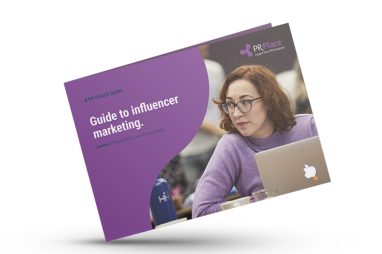Should we be capitalising on the power of the influencer in promoting healthy behaviours?
Can public health communications practitioners justify spending public money on influencer marketing and what are the risks?
About the author
Danielle Bailey prepared this article as part of a CIPR Professional PR Diploma assignment, while studying with PR Academy.


Whether we like it or not there is no question that social media influencers play a huge role in public opinion and behaviours. How many of us can say that the clothes we wear, products we buy, places we eat, even our holiday destinations have never been inspired by a late-night Instagram or TikTok scroll?
In recent years we’ve seen increasing abandonment of traditional news and information outlets, with vast swathes of the public spending more time online, and turning to digital platforms for advice and insights on, well, everything!
The ‘rise of the influencer’ has taken hold and we have seen them gain popularity, and critically, credibility as authorities on many aspects of public life, notably in public health. Be it medical professionals or celebrities using their social media to share advice, personal stories and opinion on matters such as mental wellbeing and menopause or urging us to eat more healthily, exercise and take up screening for cancers, to name but a few examples, the growing role of influencers in public health care messaging is undeniable.
Cashing in on influence isn’t anything new
Gaining buy-in from celebrity endorsement is a tried and tested method in marketing strategy. Last year the Edelman Trust Barometer reported that 66% of Gen Z adults and millennials follow influencers, with 58% of those surveyed saying they trust even paid and promotional posts and 69% stating they had made a change to their lifestyle because of influencer activity. These audiences are increasingly turning to social media for medical advice and with potential access to enormous, engaged target audiences, it is no wonder public health bodies, government departments and some NHS organisations are adopting influencer marketing.
From a communications theory perspective, embracing influencer marketing seems like an obvious choice: aligning with Katz and Lazarsfeld’s two step flow model and public trust in messaging from those they know and respect, and author of The Social Media Manifesto, Jed Hallam’s theories on opinion leaders having a key part to play in message dissemination including the ability to adapt message delivery and interpretation. However, we must consider the bigger picture: is it a safe and effective medium for public health and wellbeing messaging, and is it bringing about positive change? Or, are we essentially putting the public at risk by allowing non-experts to cascade medical advice and should public money be lining the pockets of social media stars?
Lessons learned from the accelerating effects of COVID-19
Nor is it a new element of public health communications strategy; in 2019 England’s Chief Nursing Officer put out a public call to find ten ambassadors to support promotion of the new NHS App across social media channels, but COVID-19 provided fertile ground for experimentation. A rapidly evolving virus necessitated continuous updates to public health messaging, at times on a daily basis. As lockdowns hit, cutting our social interactions and reducing the possibilities for traditional forms of messaging, like posters in doctors’ surgeries and on public transport, the potential of digital channels came to the fore. As with homeworking and virtual meetings, the pandemic accelerated the uptake of influencer marketing in public health communications strategy.
The UK government hit the headlines for its use of former Love Island contestants to promote the Test and Trace scheme, which aimed to encourage people to test for COVID-19 and then let recent contacts know of a positive result.
As trust in medical experts dwindled, the UK the government hit the headlines for its use of former Love Island contestants to promote the Test and Trace scheme, which aimed to encourage people to test for COVID-19 and then let recent contacts know of a positive result. A government spokesperson said to the BBC, “Our use of social media influencers has meant over 7 million people have been reached. As a responsible government, we will use every means possible to keep the public informed during the pandemic and raise awareness of NHS Test and Trace. This is just one part of a wider campaign utilising TV, radio, social, print and other advertisements to ensure the public has the information it needs.”
£63,000 – a princely sum?
This was the first example that we saw of some semblance of transparency around government budget for influencer marketing, but the lack of detail in spend per influencer highlights one of the key struggles all communications practitioners face – what is a reasonable cost? Add to this considerations around follower numbers, celebrity factor, how targeted an audience you may be able to reach as well as the various formats influencer content may take, and you have the beginnings of a list of the great unknowns.
The lack of clarity here also highlights another key issue; impact and measurability. Influencer marketing is widely toted as being a part of marketing strategy but is rarely officially reported on as a standalone activity in public health.
Finally, we see here one of the core reasons for hesitance in using not only influencers, but also other less traditional forms of marketing, in public health communications strategy; scrutiny over spending public money. Passing the ‘Daily Mail test’ is a concern that is still very much present in public sector communications teams across the UK, now more than ever as budgets are tightening and the cost of living crisis persists. The headlines reporting on the government’s use of influencers to promote uptake of Test and Trace widely focused on the fact that £63,000 had been spent on reality TV stars, rather than the reach and impact.
Leading by example
In Finland the Prime Minister’s Office created a Corona Facts campaign communications hub specifically for influencers, and sent a series of newsletters alongside webinars. Enabling messaging on behaviours the government wanted the public to adopt to be shared directly with individuals with huge public reach. An academic study of this campaign found that when influencers adapted government messages to their own style and shared content where they led by example they were able to impose normative influence over followers, asserting that, “exhibiting relatable in-group behaviour is how the strategic communication practice can distinctively benefit from social media influencers”.
This sheds light on how and why, as public health communications professionals, we might use influencer marketing to effect behavioural change and improve health outcomes. Kelman’s Social Influence Theory sets out the three main types of social influence as compliance, identification, and internalisation, it is plain to see that engaging influencers enables us to leverage both identification and internalisation in getting our message across. One of the key benefits being that followers often relate to influencers and trust the information they are receiving which means they are more likely to take on their advice and behaviours. Furthermore, as influencers adapt official messaging to suit the their own style they are able to add a level of nuance and emotion to the narrative which is not usually possible for those working in public health.
The wider case for behavioural influence
With a “focus on the treatment and prevention of illness by supporting patients to adopt improved healthy behaviours” as a vital part of the NHS Long Term Plan shouldn’t we be seriously considering the influencer’s role in activating the masses? There is a great deal of academic research that evidences social media influencers’ power in affecting consumer behaviours and attitudes in terms of engagement and participation, purchase, willingness to pay more and continuous consumption. Indeed in recent years they have had an increasing impact on their audiences’ spending habits. Measurement of influence over behaviours that have positive impacts on the population’s health outcomes is less clear, though there is a growing body of research that supports influencer marketing as an effective tool in promoting healthy behaviours.
Looking to the private sector, communications agency MHP Group credit their work with influencers to support AstraZeneca’s work to increase childhood flu vaccination uptake nationally and within hard-to-reach communities with campaign results including reach of over 3 million people in the UK and over 71,000 views from target audiences on creative assets.
In recent years Dame Deborah James blazed a trail sharing her personal story across social media and raising awareness of signs of bowel cancer to look out for, alongside early screening. NHS England reported, “between May and July 2022, referrals for suspected lower gastro-intestinal cancers reached record levels, with over 170,500 people referred for checks during that period – up over 30,000 compared to the same period last year… and over 200,000 more estimated visitors to the NHS website for the symptoms of bowel cancer.”
Dame Deborah’s work is well-evidenced as having been effective in influencing healthy behaviours, however the bulk of influencer impact is not recorded and shared in the same way. Campaigns like former Love Islander, Dr Alex George’s #PostYourPill have undoubtedly reached thousands of people and opened up the conversation around stigma and taking medication for mental health issues. However, it is almost impossible to measure impact and benefit in terms of mental health outcomes.
Caution is understandable
Essentially we must accept that there will always be a level of uneasiness around spending public money on influencers, especially with the National Health Service under increasing financial pressure. The lack of clear reporting on the use of influencer marketing as part of public health communications strategy, let alone the outcomes, also adds to the general reluctance and caution in embracing it.
As communications practitioners we are programmed to strategise with potential risks in mind, and there are many potential hazards in passing public health messages onto non-experts to share. The tone of messaging may contrast with the influencer’s content, making it stand apart and look obviously placed and so less likely to have intended impact. The ever-present risk is in reputation contamination by association with an influencer’s behaviour, content or a controversy surrounding them.
We’ve all heard the scare stories about inappropriate or plain wrong medical advice being shared by influencers, and though social media is a platform where misinformation is often called out, a recent study found that almost 84% of mental health videos on TikTok are misleading.
Embracing the influencer’s role in public health with risk at the heart of strategy
The benefit of influencer marketing in other sectors is clear, and a growing body of evidence and academic theory supports its adoption as a key strand of public health communications strategy. By keeping the influencer’s power to affect behavioural change at the forefront of our minds alongside risk assessment as we plan marketing activity, we can harness the potential to boost the health of the nation:
Know your target audience – ensure you have a clear definition of who is being targeted, the message you want to transmit and outline the behavioural change you want to affect.
Budget – this will always be a crucial consideration where public funds are concerned. Keep in mind that many influencers want to be associated with a good cause that benefits the public, and others are keen to share messages about issues that are close to their heart. If considering payment for influencer activity set firm limits and consider transparency in sharing activity, aims, budget and outcomes to allay public concern.
Due diligence – vet your potential influencer thoroughly; check followers against your target audience, check for controversial content and affiliations, check style and tone, look at past collaborations, their engagement rates and any statistics that prove an impact on audience behaviours such as purchase.
Use influencer theory – drill down on why you want to use a particular influencer and consider audience perception of their style and content. Are they seen as trustworthy and relatable or are they aspirational and inspiring? Think about what might work best with your messaging to bring about maximum impact.
Support adaptation – consider how an influencer might adapt your message to their own style and discuss this with them. Make your message easy to adapt and be a part of the process.
Risk planning – prediction and prevention are key stages of risk planning, according to Crisis, Issues and Reputation Management author, Andrew Griffin. Horizon scan and prepare responses to controversies that could arise. Again, consider transparency in use of influencers and be honest and open about results.
Analysis and benchmarking – track and record outcomes of your campaign to inform future activity and in the interests of transparency it may help prove value for money.
Influencer marketing, if used appropriately, can be a vital and effective tool for public health communications professionals. Potential risks can be mitigated with due diligence, carefully planned messaging and intended behavioural outcomes, and risk management planning. With an ever-evolving digital landscape in which the public are increasingly engaged, and levels of trust in medical experts at an all-time low, we must explore all channels at our disposal to improve health outcomes. Influencers have public trust, access to large, targeted audiences and are able to add nuance and feeling to messaging, which is often the key to leveraging that all-important empathy and engagement.
They have a unique ability to activate behaviours, and this is a power that we should be tapping into as part of our efforts to improve public health outcomes.
This article was researched and written by Danielle Bailey. AI was used to create the main image.


